Trip Report - 8-25-19
Sunday was a day of surprises.
To start with, the stream that had once been my favorite, before the New York City Department of Environmental Protection cut the flow from a rock-steady 31 CFS to a rock steady 11 CFS (and then to a rock steady 9 CFS), was back up to 33 CFS. Several times over the years I had seriously considered never going back. With a restored flow I just had to go back!
How good the fishing turned out to be was my second surprise. The first pool, from which I have taken six fish more than once, yielded only two. I thought "well, after years of meager flows you really can't expect it to bounce back quickly."
How wrong I was. Within the first fifty yards, I caught a 14" brown.
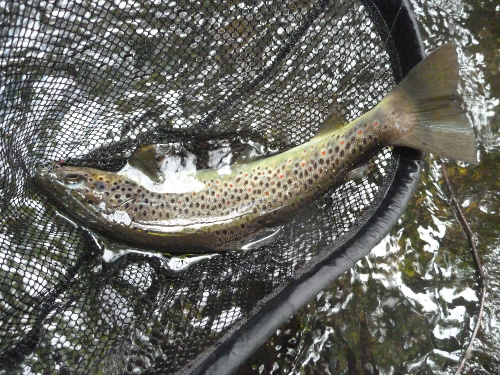
Since the flows were cut years ago, I had never caught a fish over 8" there, and most were 5 or 6"! A little later in the day on Sunday, I caught one of 10 or 11", so I suspect the fish were always there but were just very, very hard to catch with the low flows.
The day eventually proved to be either the best or second best day I'd ever had on that stream (or anywhere, for that matter). It was a many, many, many day.
The third surprise, and this is something you would notice only after catching a LOT of fish, was that there were three distinctly different spot patterns in the brown trout population of that stream.
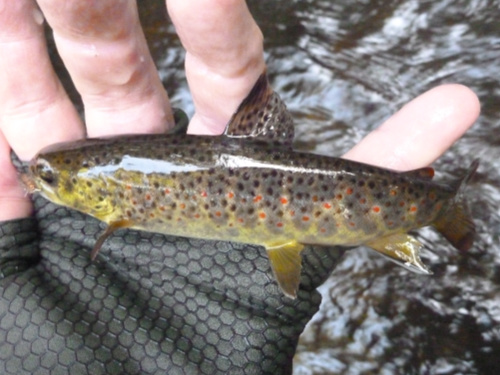
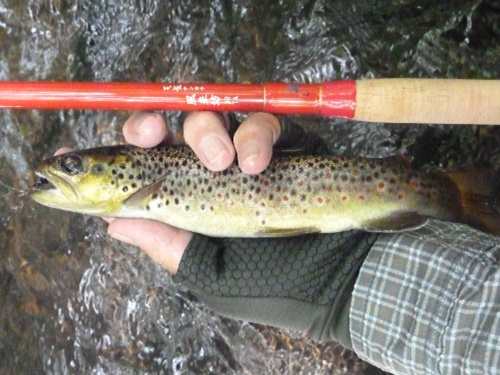
The fish in the three photos above had a mix of red spots with lots of black spots. I think that is a common pattern for brown trout, but it is not very common on this particular stream.
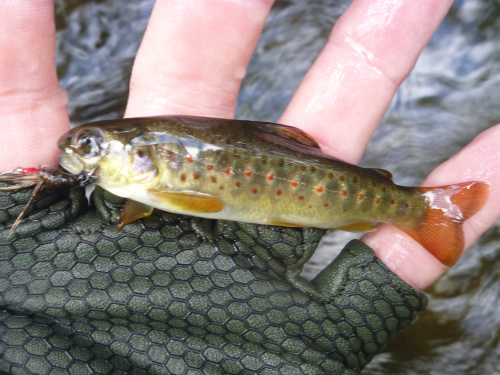
Assuming that my sample - the fish I caught - was representative of the population as a whole, the most common pattern on this stream is a distinct line of red spots along the lateral line, with few black spots below the lateral line.
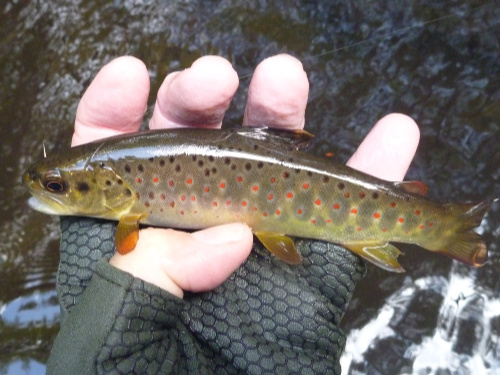
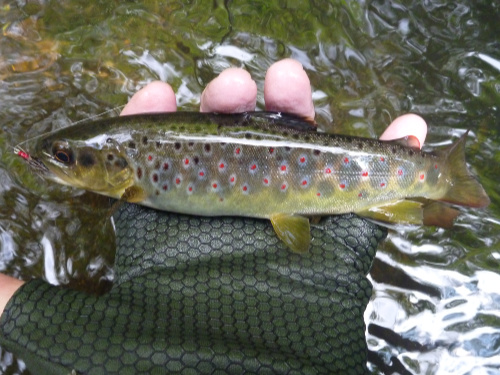
By far, most of the fish had that distinctive line of red spots. Even the fish that had a good mix of black and red spots had a line of red spots on the lateral line.
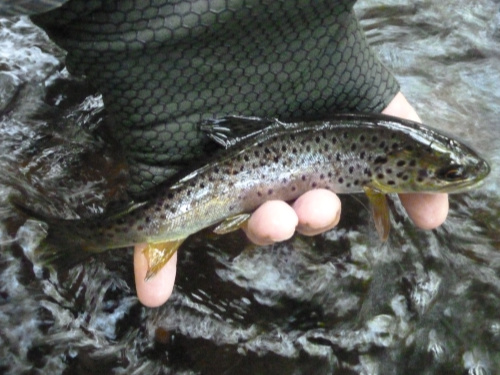
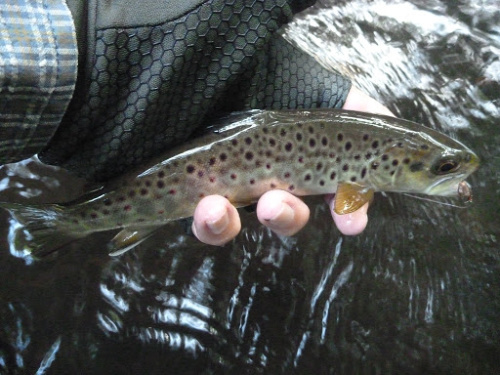
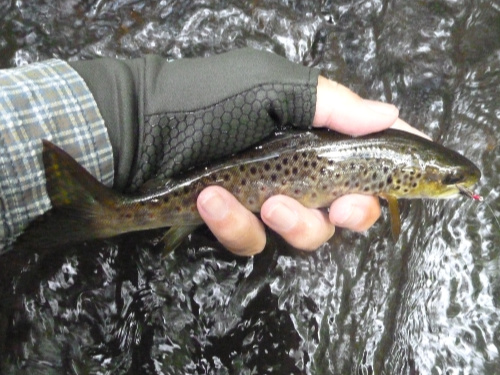
The third pattern, which was relatively rare, had no red spots at all. I have heard these browns described as the Loch Leven strain, originally of Scottish origin, while the browns with a more yellow color and bright red spots were said to be of German origin.
The stream has only brown trout - although early on in the twelve years I have fished the stream I did catch a rainbow. In a stream that has excellent natural reproduction of browns I considered it to be an invasive species so I ate it. Haven't seen one since.
On Sunday I did see something that was even more bizarre than a rainbow in a stream in which they are not stocked, which flows into a reservoir in which they are not stocked, which is held back by a dam they can't pass.

I don't know what it was, but it reminded me of the movie "Alien." The trout seemed healthy and fought vigorously. I released it and wished it well.
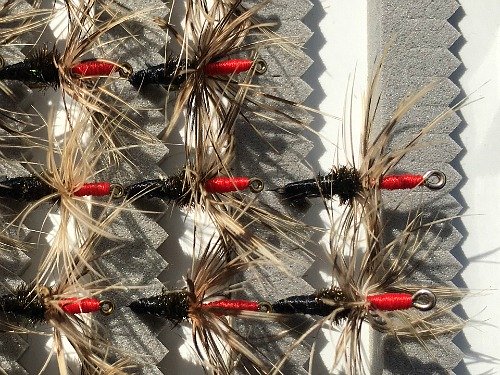 Tenryu Kebari
Tenryu Kebari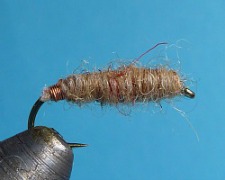 Killer Bug
Killer BugOne thing that was not a surprise, and which clearly supported a view I've held for some time and have written about in passing, was the extent to which fly choice affected my ability to hold line off the surface.
For most of the day I fished the fly I call a Tenryu Kebari. (The people from Tenryu don't call it that. Like most kebari, in Japan it doesn't have a name.) The fly has a bright red head, peacock herl thorax and a black or green floss body. Its key feature, at least for this discussion, is the thick hen pheasant hackle, tied in the sakasa style. For part of the day, though, after a tree ate the last Tenryu Kebari I had brought with me, I fished a Killer Bug. For years, a Killer Bug had been my "go to" fly for this particular stream. No more.
A kebari with a hackle that is full (as opposed to sparse like on a North Country Spider) resists being pulled through the water. That resistance allows you to keep your line a little tighter and makes it much easier to keep the line off the surface. A Killer Bug, which has no hackle, has little resistance to being pulled through the water. (As an aside, a Perdigon Nymph, which is specifically designed to sink quickly, has VERY little resistance to being pulled through the water!)
It was obvious, with my first cast of a Killer Bug, that I almost could not keep my line off the water. If I raised my rod tip to lift the line, the fly just got pulled closer, letting the line again fall to the surface.
I don't recall having read comments by anyone else about the dramatic difference that fly choice makes in your ability to keep your line tight and off the surface. Paul Gaskell and John Pearson have written about how water pressure against your fly allows you to hold it in place in an eddy (tomozuri). However, I don't recall them ever contrasting a hackled fly with a no-hackle fly. If they have, I either missed it or forgot it.
I have never seen it mentioned in a Japanese source. I suspect nearly all Japanese tenkara anglers fish a hackled fly without even thinking about it. "It's tenkara. Tenkara flies have hackle. What's there to think about?" I can't seem to find a photo of it now, but if I recall, even Dr. Ishigaki's "secret" bead head kebari has hackle.
The difference between a heavily hackled fly and a no-hackle or sparsely hackled fly with respect to line sag is dramatic, though.
Does it matter? You bet it does! Keeping your line off the water reduces drag, improving your presentations. Keeping your brightly colored tenkara line out of the water increases your catch rate. Paul and John would add "by an astounding 700%."
I will go so far as to say I think that's why tenkara flies are heavily hackled. A rod that is long, a line that is light and a fly that resists being pulled through the water are all necessary for keeping the line off the surface and also for the gentle, discrete pulses that give a kebari the appearance of life.
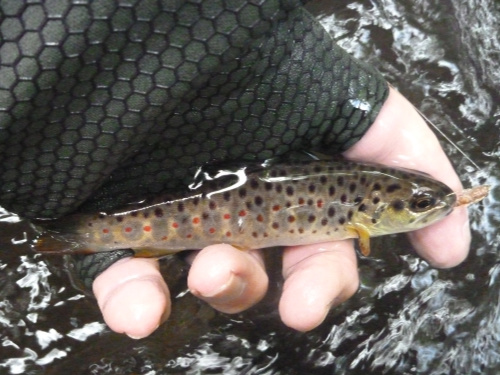
All that said, I did catch fish with a Killer Bug on Sunday. It was much, much harder to keep my line off the water, though. I was using the Sunline Visible Free white line, which seems to be less likely to alert the fish than a fluorescent orange or chartreuse or pink line. That is an idea Rob Worthing confirms, preferring a white sighter to a brightly colored one when Tactical Nymphing - particularly for highly pressured fish. Although I caught fish with the Killer Bug, I don't recall catching any fish when my line was in the water.
If you want to fish a Killer Bug or Killer Bugger or any
other no-hackle wet fly or nymph, I have an idea you might try. Years ago I
experimented with heavy tippet as a clear tenkara line.
My experiment that day was with a line consisting entirely of clear 1X
tippet (Japanese size 2.5) with closely cropped keiryu yarn markers for
strike detection. It worked extremely well with a Killer Bug but not
with an unweighted fly - the markers caused too much wind resistance, killing the cast. Come to think about it, the weight of the wet wool may have more to do with the Killer Bug overcoming wind resistance than the weight of the copper underbody.
If you don't want to mess with yarn markers, or if you do want to fish with an unweighted fly, you could use your regular tenkara line, but shorten it by a foot or two and insert that same length of heavy tippet between your line and your regular tippet. I would use -2X tippet with size 4 tenkara line, 0X with a size 3 or 3.5 tenkara line, and 1X with a size 2.5 tenkara line.
With
a no-hackle fly, the end of your "line" will likely be in the water,
but if the line that is in the water is clear it will be much less
likely to scare the fish. It certainly didn't scare fish the day I tried using it as tenkara line.
Understand that I have not yet tried replacing the last foot or two of my hi-vis line with clear tippet material of the same line weight. It may be that a 2 foot length is too long. The longer the clear section, the harder strike detection will be because your hi-vis line will be further away from your fly.
The ideal length would be the amount of clear line that lets the end of your hi-vis line always remain above the surface, but still shows a little bit of the curve caused by line sag. That curve going straight is the most sensitive strike indicator there is.
Of course, if the aspect of tenkara you value most is simplicity, don't complicate your line or your life. Just fish a heavily hackled wet fly and don't think about it.
TenkaraBum Home > Trip Reports > Trip Report 8-25-2019
“The bitterness of poor quality remains long after the sweetness of low price is forgotten” - Benjamin Franklin
"Be sure in casting, that your fly fall first into the water, for if the line fall first, it scares or frightens the fish..." -
Col. Robert Venables 1662
As age slows my pace, I will become more like the heron.
We've all had situations where seriously chewed up flies kept catching fish after fish after fish. It is no sin to tie flies that come off the vise looking seriously chewed up.
Warning:
The hooks are sharp.
The coffee's hot.
The fish are slippery when wet.
Beware of the Dogma
What's in stock?
Suntech Tenkarakyo 40F Tenkara Rods
Coming Soon
December
Kurenai II AR 30F
Kurenai II AR 33F
Kurenai II AR 39F
Nissin Oni Line size 3
Nissin Oni Line size 3.5
TenkaraBum 33
TenkaraBum 36
TenkaraBum 40
Medium Rod Case
January
Furaibo TF39
Furaibo TF39TA
Latest Pages
If you enjoy spin fishing or baitcasting please visit my sister site Finesse-Fishing.com.


